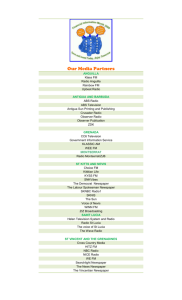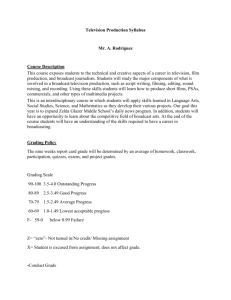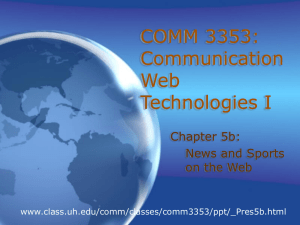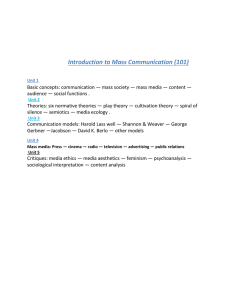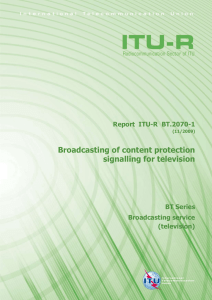Essay 1 Final Draft
advertisement
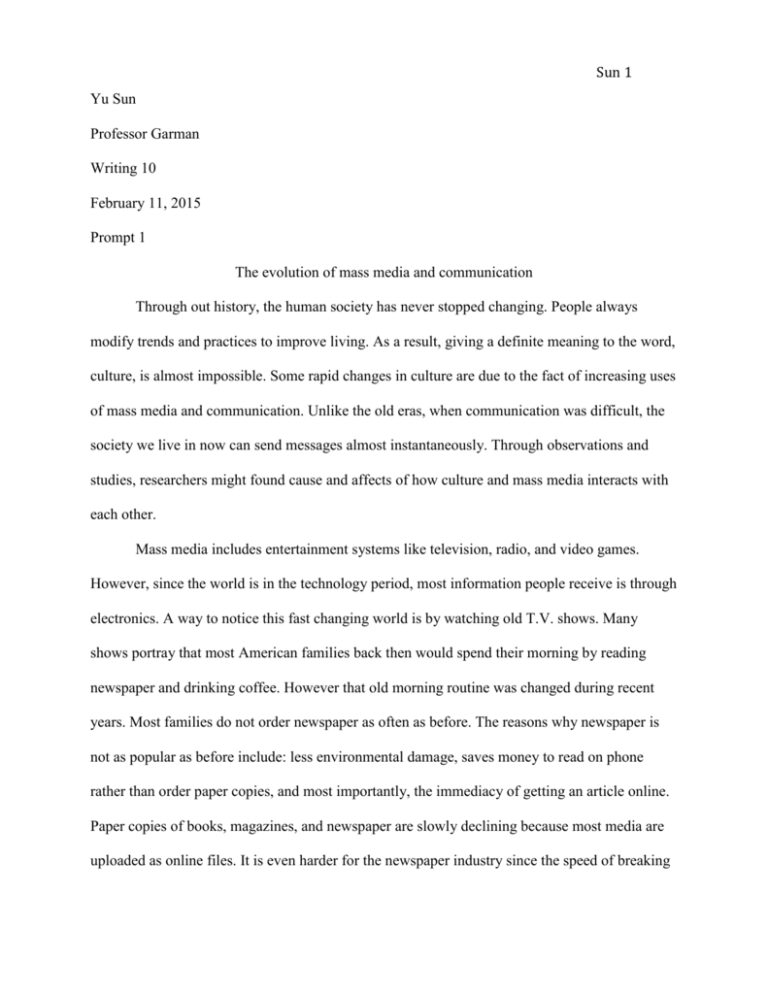
Sun 1 Yu Sun Professor Garman Writing 10 February 11, 2015 Prompt 1 The evolution of mass media and communication Through out history, the human society has never stopped changing. People always modify trends and practices to improve living. As a result, giving a definite meaning to the word, culture, is almost impossible. Some rapid changes in culture are due to the fact of increasing uses of mass media and communication. Unlike the old eras, when communication was difficult, the society we live in now can send messages almost instantaneously. Through observations and studies, researchers might found cause and affects of how culture and mass media interacts with each other. Mass media includes entertainment systems like television, radio, and video games. However, since the world is in the technology period, most information people receive is through electronics. A way to notice this fast changing world is by watching old T.V. shows. Many shows portray that most American families back then would spend their morning by reading newspaper and drinking coffee. However that old morning routine was changed during recent years. Most families do not order newspaper as often as before. The reasons why newspaper is not as popular as before include: less environmental damage, saves money to read on phone rather than order paper copies, and most importantly, the immediacy of getting an article online. Paper copies of books, magazines, and newspaper are slowly declining because most media are uploaded as online files. It is even harder for the newspaper industry since the speed of breaking Sun 2 news will be posted on web before narrators have time to publish their articles. There are more changes in our culture because of the “multiple platforms for presentation” (Traudt 11). For example, the quality of news articles is not the same as the it was twenty years ago. Since reporters have less time to edit their articles, the paper contained more grammar errors than before. Another major change in the society is the different styles of music played by different ethnic groups. Countries around the world all have their own unique preferences in music. However those unique preferences are slowly emerging into a style that is more likely to be accepted around the world. A reason why taste of music is changing might be cause by the recent methods of how music is promoted. In the U.S., the shift from radio stations to online net workings is a part of the cause. Paul J. Traudt summarized his opinions of radio broadcast as “they still served as an support to sale the prerecorded music, but only as a supplement to niche cable network programming services such as MTV and VH1” (Traudt 7). It was not surprising to hear this change because the advancement in mass media has decreased the uses of old technology. Back in the 90s, almost every house had a radio in their living room, but as time went by, those old fashioned radios are replaced by better performance television and audio sets. It seems like most families don’t have a system for playing music that doesn’t involve headphones. In order to keep up with the high standard demands of customers, the music industry modified the way in which they sell music. Therefore it is clear to see how mass media has affected the taste preference of the society that leads to changes in culture behavior. The last part of mass media that changed culture is broadcast television. With the increase uses of smartphones, computers, and tablets, people have an easier time finding what they want to watch. Social media like YouTube allows viewers to stream videos without the Sun 3 hassles of sitting in front of the television at certain time periods. Thus, “broadcast television no longer dominates the television scene.” (Traudt 8) People may not think there is a direct connection between broadcast television and the changes in cultures, but surprisingly there is. When more viewers prefer to use other devices to watch media, they are eliminating the use of televisions, which will change how future generations enjoy entertainment. American culture is a classic example in which culture changes are some what affected by mass communication. As one of the leading countries around the world, America shares much information with other places. While massive amounts of information are shared to other countries, America also takes in new ideas through the process of communicating. New innovations are created through the use of those new ideas. Therefore, it would be impossible to get advanced without the use of mass communication. In order to better understand the idea of how mass communication affects the culture, one must understand what the term means. Traudt explains the term as “the process by which individual audience member engage and give meaning to media contents” (Traudt 11). Therefore, consumers give different meaning to texts, creating this huge pool of diverse thinking. Before the invention of telephone and computers, writing letter and telegram are some of the few options one can choose to contact others who are far away. Compared to those old methods of communication, modern day inventions speed up the process and increased connection coverage to other parts of the world. In today’s society, anyone can stay connected with the usage of the Internet. People are interacting with each other more than ever before, but most communications are not done physically. From those virtual connections, cultures around the world are slowly changing as online communications take over physical meetings. This sudden creation of mass communication affected cultures to be more diverse. Sun 4 New ideas and information are constantly updated through mass communication. Although most communications are said to be private, it is impossible to hide any secret once it is send through the Internet. As a part of the large communication, media employs different culture believes to improve the contents, those contents will be later then stored as communication. The interrelationship between mass communication, mass media, and culture recycles when new data are inserted into the circle. As a result of those newly formed communications, cultures are also adjusted to fit the expectation of the new information.


